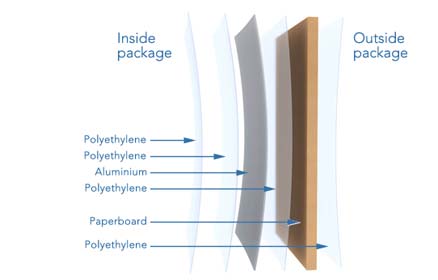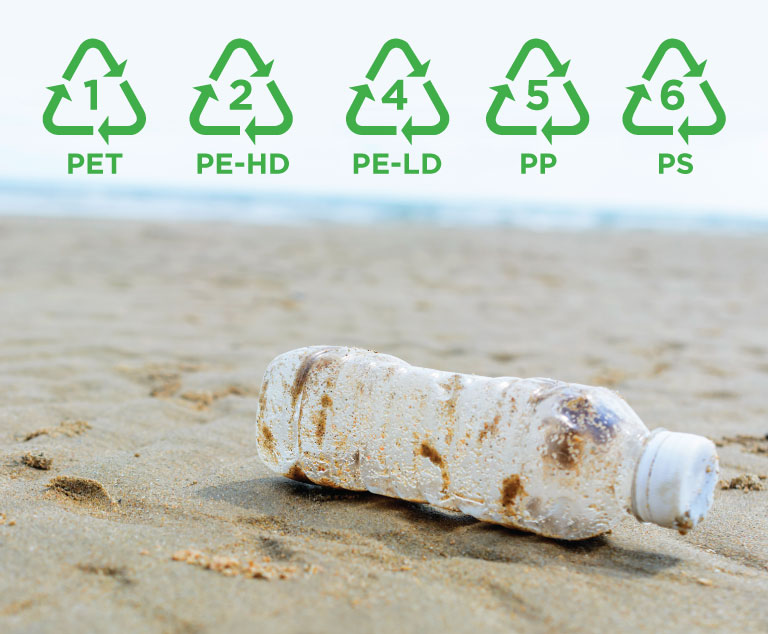What is a Tetra Pak made from?
Tetra Paks are made up of a number of components which are layered:
paperboard (made from wood), polyethylene (a type of plastic) and
aluminum. These different components give Tetra Paks their unique
properties: keeping the liquids in but the microbes out, and a strong
but lightweight container.

When a Tetra Pak is recycled, all these component parts need to be separated out.
What Does Recycling Mean?
Whilst recycling can be thought of as a way of converting waste into a
new material, more accurately it means a process to return material to a
previous stage in a process that operates as a cycle. After all, the
word is “re-cycling”. The idea is to take a used product and turn them
back into the same type of product, such as glass bottles being melted
down and formed into new glass bottles. There is no loss of quality, so
this recycling of glass can go on forever.
When a product doesn’t get turned back into the same product, but one of lesser quality (as with plastic recycling)
it isn’t recycled, it’s downcycled. Products that are downcycled often
only undergo a limited number of cycles (maybe as few as 2) before
reaching the end of their useful lives and ending up in landfill.
For Tetra Pak to be truly recycled, these layers of paperboard,
polyethylene and aluminium would need to be separated out, and reformed
to make new Tetra Pak cartons. However, that isn’t what happens.
Why Tetra Paks aren’t Sustainable
If Tetra Paks are recyclable, why aren’t they green? Let’s look at
the different components, where they come from and what happens to them
once the cartons are empty.
Paperboard (Wood)
Tetra Pak have devoted a significant amount of their website space to
telling customers how sustainable their containers are. As well as
talking at length about Tetra Paks being recyclable, they inform us that
Tetra Pak source FSC-certified wood for 41% of their cartons worldwide (2013 figure). This equated to 32 billion FSC-labelled Tetra Paks reaching consumers in 2013.
Let’s look at this another way.
If 32 billion containers is 41%, then the amount of non-FSC wood
Tetra Paks reaching consumers would be 46 million. 46 million containers
made from non-renewable sources? That is a lot of wood. Tetra Pak might
have a goal to reach 100% FSC-wood, but it isn’t happening now.
When this paperboard is recycled, it isn’t turned back into new Tetra
Paks. It is unclear whether this is because their paperboard needs to
come from virgin sources to avoid contamination (as is the case with
plastic), or whether the quality of the recycled paperboard isn’t high
enough to make new cartons, or some other reason. Whatever the reason,
it is turned into office paper.
Plastic and Aluminium
The other two layers of the Tetra Pak, polyethylene (plastic) and
aluminium, cannot be separated by the recycling process and remain
combined as a “polymer”. The uses for this “polymer” is in the cement
industry, or as low-cost housing material. The question arises, is there
a genuine demand for this product, or is there a market because of an
abundant supply of this waste material?
The fact that it gets reused and isn’t sent to landfill is great,
except it doesn’t serve to make Tetra Paks a “green” solution. These
cartons use fresh plastic and aluminium to make their cartons, and the
waste products becomes something else entirely. Thus it is a linear
system, not a cycle – and anything that is linear cannot be sustainable
long-term.
A Word on Recycling Tetra Paks
The other thing to alwyas remember about recycling, is just because something can be recycled, it doesn’t mean that it will be recycled.
The two are very different.
The Conclusion
Tetra Pak may want to be sustainable; they may want
to use 100% FSC wood and achieve 100% recycling rates, but they still
have a long way to go. Even if they achieve this, there’s no getting
away from the fact that Tetra Pak production is a linear process. Tetra
Paks are turned into different post-consumer products, meaning a
constant supply of fresh virgin material (wood, oil and aluminum) is
needed for their manufacture.
So after we drop our empty Tetra paks into the yellow container, they do go to a recycling plant but are not made into new Tetra paks but something else. That is a huge problem because there are a lot of products in Tetra pak containers but finding alternatives is not too difficult.
The blog song for today is : "Perfect Day" by Lou Reed
TTFN









